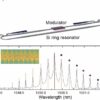When forming an image of an object, such as a photograph taken by a cell phone, light that has interacted with the object and either passed through or bounced off it is captured by the detector in the phone.
Some 25 years ago, scientists devised another, less direct way to do this. In the conventional form, information gathered from two detectors are instead used, by combining information from one capturing the light that has interacted with the object and one that has not interacted with the object at all. It is the light that has never interacted with the object that is used to obtain the image, though, resulting the technique taking on the name “ghost imaging.”
When entangled light is used, the quantum properties can be exploited to do this at very low light levels which can be a large advantage when looking at light-sensitive samples in biological imaging where too much light can damage or change the sample and thus destroying what one wishes to look at—this being quite a conundrum in the field.
Using either direct or indirect imaging, the images being formed is a result of how much light is let through and thus a result of the transparency of the object. There is, however, another type of interaction that objects can have with light which can reveal some important information and show rich features.
This is the speeding up or slowing down of the light that passes through, which is shown as phase. This means you can see more features and properties of the objects you are imaging such as variations in thickness (giving one 3D information) or if there are different transparent materials inside that have large enough variations in the refractive index that it changes the phase of light. And because this is from all the light passing through you would not be able to conventionally detect it, often requiring complex strategies and arrangements to do so.
Researchers at the Structured Light Laboratory at the University of the Witwatersrand (Wits University) in South Africa have recently developed a method to do this in a very simple way by exploiting ‘side effects’ in traditional quantum ghost imaging. The research was published in the journal Optica.
“We can see phase, a hidden feature of objects that is usually very hard to reveal, but enormously powerful if you can. For instance, it is how LIGO can detect gravitational waves. Now we can show the hidden phase in objects easily, giving access to internal structure of living systems, bringing a 3D (thickness) rather than just 2D information of regular objects, and opens a new approach to quantum metrology—the quantum version of LIGO, so on,” says Professor Andrew Forbes, the leader of the lab at Wits University.
To detect the ‘ghost’ image from the non-interacted light here, researchers have a choice of two methods. One is to use a charge-coupled device (CCD), like that in your phone, but highly ‘intensified’ in order to see the light in its smallest form as photons. This, however, comes with an equally intense price tag.
The other option can be a simple ‘single pixel’ detector, which can only see how much light is gathered and cannot give you any spatial information. Here masks that let light though in a chosen position can now instead be placed and changed in front of this detector to reveal the spatial information and allow one to reconstruct the image by adding all of this information together.
This allows much more versatility in terms of both the wavelengths and efficiency of the light being detected, along with a much lower price point. This, in fact, was the method of use before the development of the more sensitive cameras and what the team exploited in order to detect phase information.
“Taking the LIGO analogy further, you might think that to see phase is very complicated and expensive. Indeed, this has been the situation in the quantum world too, with existing approaches using fancy cameras and sophisticated optical systems, which are bulky and expensive. Our approach allows us to see all of this with just a single pixel detector,” says Forbes.
“Our approach allows excellent resolution with a detector with essentially no resolution. We get this right by a digital trick that no-one had realized before. This hidden phase information was always there, but you had to know where to look for it.”
They did this by realizing that certain masks are naturally sensitive to the phase component based on how you construct them and can be intelligently engineered to reveal full detailed phase structure along with the conventional information that the technique is usually used for. In doing so, an extra layer of usefulness is added to the way samples can be imaged in single pixel imaging with quantum light, giving the potential to see in 3D—revealing how thick or thin the objects are, even transparent ones.
“We found the information was hidden in the technique all along and with a bit of tweaking can let you see very rich and interesting features,” says Bereneice Sephton, the first author of the paper who worked on the project along with colleagues at the Structured Light Laboratory, Dr. Isaac Nape, Chane Moodley and Jason Francis during her Ph.D.
“We hope this can be used for, among other things, the imaging of sensitive biological samples to see features and properties that would have required much more complicated or expensive means without it.”
More information:
Bereneice Sephton et al, Revealing the embedded phase in single-pixel quantum ghost imaging, Optica (2023). DOI: 10.1364/OPTICA.472980
Citation:
Revealing the embedded phase in single-pixel quantum ghost imaging (2023, February 21)


